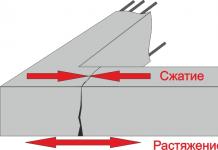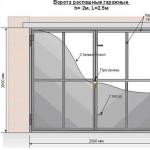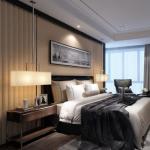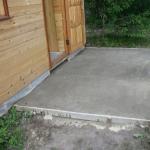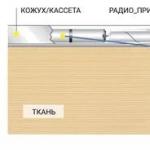Beautiful elements in modern design living space able to provide comfort and harmony in your home. Today, French curtains in the interior are considered a fairly popular option for decorating window space. Thanks to them, a warm and mysterious atmosphere appears in the room. They are often used in country estates and spacious apartments.
You can create such a model yourself at home. Our material presents detailed instructions how to sew french curtains effortlessly. All the subtleties of the workflow are noted here.

The advice of experienced professionals will help you make the correct calculation of the material and the frequency of weightless waves.

How to choose material for curtains?









Curtain fabrics may contain a small amount of lurex. beautiful glitter under sunbeams will add a piece of luxury to the interior space.

Marquise curtains are often used in classic design. They will become a real decoration of your home. There are several criteria when choosing a fabric for sewing curtains:
- soft texture. It allows you to create a large number of air folds on the surface of the material. Thicker fabrics are intended for big waves which are used to create lambrequins;
- heavy materials (jacquard, natural linen) will help to make large folds;
- French curtain in the kitchen, must be made of synthetic fabric. Pretty designers prefer to use organza or tight tulle. These materials lend themselves well to cleaning;
- do not choose fabrics with a small pattern in the form of flowers or geometric shapes. During drapery, the decorative elements of the material will be lost against the background of the window space. As a result of this, a tasteless detail may appear in the interior, which will constantly distract.

Ready-made Roman blinds can be supplemented with a beautiful lambrequin. A luxurious duet of dense and airy material creates a truly sophisticated design.

Basic rules for combining fabrics
Marquise curtains require a competent combination of fabrics and materials. You can create beautiful smooth waves using several types of fabric. The veil is in perfect harmony with thin organza. It also looks good in a duet with dense satin or natural linen.

You can add decorative elements with the help of voluminous tiebacks or beautiful beads enclosed in a long shiny cord. During drapery, the crystal bugle will gently descend along the edges of the air waves.










How to calculate the amount of fabric to create curtains?
There is a certain technique that provides for all the subtleties of the workflow. As noted above, the first step is to correctly calculate the distance between the waves.

To do this, multiply the length by 2 and add the required distance for allowances. Basically it is 4-6 cm from each edge. An allowance of 5 cm is made at the bottom. As you can see, everything is quite simple.

For sewing a small curtain, you will need 3-4 m of an air veil. Size finished curtains will be 2 m. These parameters are enough to decorate a small window opening.









Patterns for Roman blinds
At the beginning of the workflow, it is recommended to define the model. There are several types of curtains, which differ in the number of folds on the surface of the fabric. Modern options provide for the presence of a secret drawstring, which will regulate the assembly of the material.

The pattern is a large rectangle with additional marks for a hidden lace. The distance between them is calculated based on your preferences.

It is worth noting that the closely spaced drapery creates lush curtain patterns that are suitable for a living room or bedroom.

Stages of creating curtains
The algorithm for self-creating French curtains consists of several stages:

- processing of cuts and edges of fabric. For this, the material is placed on flat surface preventing the appearance of unnecessary wrinkles;
- a bend is made in the lower part and fixed with a needle and thread. On average, it is 5 cm above and below;
- further mark the position of the hidden wings. They will continue to provide the necessary air waves;
- after that, a lace is pulled into the drawstring, which will be in the role of a canvas retainer;
- the final step will be to attach an additional tape with places for attaching hooks. They help to evenly attach the curtains to the eaves.

Such lightweight curtain designs will be a real decoration for a bedroom, kitchen, living room or even a balcony. They are able to fill the interior with an atmosphere of lightness and romance. Even in ancient times, they were used to decorate luxurious castles and estates.









Today they are used in baroque, rococo or classic style. They will never go out of fashion. The photo of French curtains captures the best options for decorating window space.

Photo of French curtains











These curtains, also called awnings, are distinguished by beautiful uniform folds (scallops) along the entire length of the canvas. Their homeland is France, where they appeared in the XVIII century. Awnings were sewn exclusively from expensive fabrics and were used to decorate windows in the houses of nobles.
The principle of operation of French curtains is a special cord lifting mechanism that holds the canvas in a certain shape.
Many people confuse awnings with Austrian curtains. A distinctive feature of the former is that they have folds (scallops) along the entire length of the cloth, and austrian curtains- only on the bottom edge.
Marquis classification
There are French curtains:


- workers- they are used in new types of cornices and are regulated by means of a lifting mechanism controlled by a remote control;
- Decorative- canvases, which are controlled exclusively by hand.
Applications
Initially, awnings were used to curtain windows in rooms for celebrations - banquet halls, palaces, theaters, restaurants. But they can also be used in conditions ordinary apartment, Houses. These curtains, due to their splendor, are perfect for decorating windows in the living room, bedroom. In the hall, the French curtain will become the main accent of the interior; against its background, ordinary furniture will seem expensive and refined.

French curtains will add romanticism and elegance to the interior of the bedroom. All this thanks to the soft folds that carry the charm of France. Even in the children's room, awnings will be appropriate. Made from thin material, they will give the room lightness. You can decorate them with bows, butterflies, decorative elements that will be of interest to the child.
Advice: for a nursery, it is better to choose French curtains up to the windowsill, so the child will not touch them during the game.

The classic design of the kitchen is complemented by elegant awnings. They will turn any meal into an important feast. The length of the curtain should also be small so that the product does not interfere with cooking and cleaning.
French curtains in the office will be appropriate. They emphasize the formality of the situation and the importance of the conversation.

The effect produced by French curtains will depend on the type and texture of the material used for their tailoring, as well as the conformity of the design of the product with the dimensions and style of the room. Considering that the awnings were originally intended to give the room a solemn look, they will look good in rooms with large windows and high ceilings.
This window drapery will give the interior sophistication, nobility, solemnity, and even some pomposity. It will adequately frame the awnings and give the interior a finished look with a lambrequin, or classic curtains.
Production of French curtains, materials

Awnings are sewn from light fabrics - silk, cambric, organza, veils. Classic french curtains Made from thick silk, pleasant to the touch. It can be smooth, or have a damask pattern. This texture of the canvas allows you to form beautiful, smooth folds from it.
From synthetic materials for sewing awnings, polyester is used. In terms of performance, it is superior to silk, but is more practical and cheaper.

Design features
Curtain width in ready-made corresponds to the length of the eaves, or slightly exceeds it (for the formation of assemblies). When sewing a product with your own hands, it is necessary to make allowances for the formation of scallops along the height of the fabric (this indicator exceeds the size of the finished product by 1.5-2.5 times).

Material calculation
To form the drapery, special rings and gathering braid are used. Its length is calculated by the formula: l=h*f+h. Where h is the height of the cut of the canvas, f is the number of scallops.
Features of cutting fabric

Before starting to draw up a sketch, it is necessary to take measurements of the window opening. Next, you need to determine the width of the product. To do this, the length of the cornice board (width of the window opening + 5 cm) is multiplied by 2 and 10 cm is added to the resulting figure (allowances for two hem seams. This calculation formula allows you to make small assemblies along the width of the fabric. If you do not need them, then the width of the panel must correspond to the length of the cornice + 4 cm is added to the processing of the curtains from the sides.
To calculate the length of the curtain, the formula is used: h (desired product height) * 2 + 2 cm (for the design of the top seam) + 5 cm (for the bottom hem).


In order for the curtain to look beautiful, not sag and not be too stretched, it is necessary to determine optimal amount festoons. A table will help in this, in which the number of warehouses is calculated depending on the width of the curtain panel.


The optimal distance between the scallops is 50-60 cm. But narrower folds can be formed - about 30 cm wide. The vertical distance between them should be in the range of 12-24 cm.
Advice: so that the French curtain does not rise when there is a draft, or when a window is opened, special weights are sewn to its lower edge.


After cutting, you will get a rectangular piece of fabric. On the back side of the panel, the location of the scallops is marked. To do this, outline the vertical and horizontal lines along which the gathering braid will be sewn. After that, the curtain is turned inside out. The braid is preliminarily fixed on the cloth with pins so that its lower end coincides with the edge of the awning. On the sides of the product, the braid is placed close to the side edge.

The lower edge of the braid is tucked 2.5 cm, having previously ironed and pulled out the cords from it to tighten the folds. When processing the sides, the edge is cut off and processed with a seam "in the hem".
Next, proceed to the formation of the top of the curtain. The curtain tape is applied to the fabric 4 cm from the front side and stitched together. The product is turned inside out, and stitched again along this first line, and then pass along the bottom edge of the tape. This stage of sewing curtains can be final. After this, the cords of the tape are pulled together, forming folds.

On a note: on the upper edge, you can make a small scallop (0.5-1 cm), which will cover the hooks. But for this, at the cutting stage, double the height of the scallop should be laid.
If the awning is lifting, the locations of the rings are marked on the cloth. Their bottom row should be located at a height of 5 cm from the lower edge of the awning, and the top row - 12 cm. Sew the rings in 4 stitches with a double thread, securing the part with a double knot. The formation of folds begins only after sewing on all the rings. The braid threads are pulled together neatly, making uniform folds. The width of the upper border is adjusted in size to the cornice board. The ends of the threads are tied as close to the cloth as possible and cut off.
Next, proceed to fitting the cornice board with a finishing cloth. To do this, the tape is cut to the width of the finished curtain. That part of it, where the hooks are located, is nailed to the front edge of the eaves board with small carnations. The second side is sewn to the braid located along the upper edge of the awning. The curtain is attached to hooks driven into the board, carefully aligning the panel.

The cords are threaded into the rings, starting from the bottom edge of the product. Each ring is secured with a knot at the bottom. At the top, all ends of the cords are passed through the hooks of the cornice board and the curtains are brought out to one side. Then they are pulled together, evenly placing the folds over the entire panel of the awning. Fasten the scallops with ribbons.
After installing the cornice board with the awning over the window, the ribbons are removed and the curtain is lowered. The connected ends of the cords are tied in a knot so that it is located behind the last hook. Then they are threaded through the handle to raise the awning and another knot is tied at a distance of 46 cm from the first. Next, the ends of the cords are cut off, fasteners are installed, around which the cord is wrapped to fix the curtain in the desired position.


Ways to combine awnings with other types of window framing

French curtains match perfectly with:
- curtains;
- Lambrequins;
- Fringed;
- Golden threads (muslin);
- glass beads;
- Kantami.
A win-win option - a combination of awnings with curtains classical type. Scallops framed by a lambrequin also look beautiful.
Advice: various decorations, accessories - decorative cords, fringe, beads will complement the folded canvas. They will give the product individuality and originality.
Awning care
French curtains are unpretentious in care - it is enough to periodically clean them with a vacuum cleaner. Awnings made of synthetic fabric can be washed. Ironing of the product is done in a wet state. But if these curtains are made of natural material, it is not recommended to wash them yourself - the folds may lose their shape.

Proper care will keep your French blinds in top condition and extend their lifespan by several years.
Video: Luxurious French curtains
If you want to decorate the interior of the kitchen with luxurious, but at the same time light and practical curtains, pay attention to the models of French curtains. They are a single piece of fabric, the length of which can be adjusted at your discretion, turning the fabric with lush scalloped folds using a vertical braid. Having chosen French curtains for the kitchen, they can be used both independently and in an ensemble with other curtains. But in any case, they look elegant, stylish and give the atmosphere of the room a truly Parisian charm and a bit of palatial pomposity.
Curtains with lush scallops were invented to decorate the interiors of banquet halls and bedrooms of the French nobility (which is why their second name is “marquise”), then spectacular textiles began to be used to decorate theater scenes. And today, almost three centuries later, French curtains are still associated with wealth and success, and can decorate the windows of any room in our house - from the interior of a romantic bedroom to cozy kitchen.
Light and airy French-style draperies
5 reasons to hang French curtains in the kitchen:
- Short draperies do not block access to the window and window sill, but thanks to spectacular scallops they look much more respectable than Roman or roll structures.
- They go well with other types of window textiles - curtains, lambrequins.

A short curtain in a duet with a luxurious lambrequin fits perfectly into the interior of the kitchen
- The number and splendor of the folds can be varied at will, so the "French" looks great both on a small narrow window and on a wide opening.
- Thanks to the lush folds, the French curtain closes the room well from prying eyes, so it can be used even in the kitchen on the ground floor without blinds or thick curtains.
- Such a curtain will be an ideal addition for both expensive historical interiors (classic, baroque, renaissance, empire), and for kitchens decorated in the spirit of a cozy country, romantic Provence or elegant English style.

Lush scallops in a classic kitchen interior
On a note! Many people confuse Austrian and French curtains, because the models are really similar in the form of folds, the lifting principle and a solid canvas. The difference is that French curtains have scallops all the way down and do not fully unfurl even when the curtain is down. And the Austrian ones form folds only in the lower part of the canvas.

Varieties of lifting curtains
Choosing fabric for curtains
French curtains for the kitchen can be of any length - as practical short curtains to the windowsill, and lush drapery "to the floor." There are no special restrictions in the choice of textiles. The material can be airy or quite dense, the difference is in the form of folds (the heavier the canvas, the more clearly the arcs will be expressed). Dense soft tissues will fall in smooth "waves", and the lungs will help form lush "clouds".

Colored transparent textures perfectly scatter light
The most popular types of fabrics:
- Translucent - veil, organza, muslin, silk, cambric, chiffon, tulle, polyester with various additives.
- Opaque - satin, cotton, linen, jacquard.


Plain textile with multi-coloured braid
As for colors, curtains can be any color of the rainbow, although white and other neutral tones are usually preferred. But textiles with a pattern are used infrequently, because when the curtain is raised, the beauty of the pattern can be lost in the folds. But if you really want to revive the interior of the kitchen with a colorful print, use light-colored fabric with a repeating colorful ornament (peas, cage, flowers).

Floral motifs in the interior of the kitchen

Can be used for sewing plain fabrics different colors
On a note! To finish the lower edge of the curtains, you can use lush ruffles, a fringe of gilded threads or glass beads, a spectacular border bright color. The choice of decor depends on the density of the material and the style in which the interior of the kitchen is decorated.
Systems for scalloping
Distinctive feature French curtains - a cascade of even arched scallops. IN classic version curtains are mounted on profile cornices, which allows you to form more lush and expressive folds. In the modern interpretation, the canvas is attached only to the upper holder with special Velcro, like other lifting models.
Types of lifting mechanisms for French curtains:
- Manual - curtains are raised using a system of several cords and rings.

- Automatic - just flick a switch or press a button on the remote control to activate the roller, which will rotate and gather the shade on desired height on one's own.
The working principle of the automatic lift
On a note! The simplest design"French" can also be static - that is, the folds will be fixed in one position without a lifting mechanism. For short curtains for the kitchen, this can be a good and very economical solution. .
We sew French curtains with our own hands
Ready-made models with lush scallops are quite expensive, but if you have a sewing machine and a desire to create a unique window decor in the kitchen, you can sew French curtains yourself. Despite the apparent complexity of the design, such work is quite feasible even for a novice seamstress. Therefore, we will consider in detail all the nuances of the upcoming work - from window measurements to the manufacture of the product itself.
Material calculation
The key to success in tailoring any curtains - correct measurements. Therefore, we arm ourselves with a tape measure and go to the kitchen window.
We are interested in four main parameters:
- The length of the cornice, to which a margin of 1.3-1.5 should be added, in order to beautifully drape the opening with fabric and leave an allowance for the seams.
- The height of the future curtain, which is measured from the cornice to the window sill or the middle of the window (however, if we are talking about a kitchen-dining room with a large opening, you can sew a curtain up to the floor).
- Assembly coefficient - depends on the type of textile, splendor and bending of the folds. For dense material, you need to multiply the length of the curtain by 1.8-2, for light tulle, chiffon or veil - at least 2.5.
- The number of stripes with scallops - the length of the cornice should be divided into 4-5 equal segments (or more - depending on the size of the window).
An example of calculating the fabric for a French curtain in the kitchen:
Given: standard window with a two-meter cornice, curtain length - up to the window sill (175 cm).
Determine the width: multiply the length of the cornice by 1.5. Total: 2 m * 1.5 = 3 meters.
We determine the height: we multiply the length to the window sill by 2.5 (assembly factor for lush scallops). Total: 1.75 m * 2.5 = 4.375 m (including allowances - 4.4 m).
To form 8 rows of scallops on the curtain, the fabric will have to be cut into canvases. But if you can find desired material in a narrow roll, 80 cm wide, - this will be perfect option for the beginner seamstress. According to our calculations, such matter will need 17.6 meters (4.4 m * 4 canvases) with a width of each row of folds of 35-40 cm.

Material calculation scheme depending on the number of scallops
In addition to the fabric, you will need a curtain rod for attaching curtains, rings and a skein of nylon cord - all this can be bought at a sewing accessories store. And, of course, you can’t do without a set of home craftswomen - sewing machine, scissors, thread, needles / pins and a measuring ruler with chalk for marking.
Tailoring technology
To get a spectacular curtain with lush folds, it is important not only to correctly calculate the amount of material, but also to provide tucks in the right places of the drapery, and even correctly fix the rings for the lifting mechanism. In order not to miss any of the upcoming stages of work, we suggest using our hint.
Step-by-step instruction for sewing French curtains with your own hands:
- Sew the pieces of fabric together to obtain the desired width of the curtain.
- Lay the resulting whole canvas on a table or other flat surface.
- Make a markup, indicating with chalk the location of the center lines of the scallops, taking into account the allowances for the seams (at the bottom and on the side - 5 cm each, and on top - along the width of the curtain tape or Velcro).
- Finish the bottom and sides by folding the fabric twice and secure the fold with a straight stitch.
Advice! For convenience, you can first baste the seams by hand or pin them with pins, and then iron them with an iron.
- Now it remains to form the scallops. To do this, from the sides, along the seams that fastened the strips and along the markings of the center of the scallops, it is necessary to lay a French (or linen) seam, with large stitches through which you can pass the gathering cord. "marquise" tape) and attach to the wrong side of the product with a regular stitch.
On a note! For a curtain under a two-meter cornice from our example, consisting of four sheets of fabric, you will need 9 seams and 9 cord cuts of 175 cm each.
- Then we take a pin, pass the cords through the seam loops and collect the curtain with beautiful folds. After that, you need to tighten each end and sew to the bottom of the curtain. To get beautiful folds, you can make small tucks in the center of each row of scallops or limit yourself to only the first row from the top, allowing the rest to form arbitrary “waves”.

Pattern for sewing French curtains with your own hands
- On the upper edge we make a bend, then we attach a mount to it - a curtain tape or one of the sides of the pile. After that, we adjust the width of the product according to the size of the eaves.
At this stage, you can finish the assembly - the curtain is ready. It remains to smooth the fabric, attach it to the hooks of the eaves or combine the sides of the fluffy tape on mounting plate. But if you want a movable rather than a static curtain, you will have to work a little more.
Installation of the lifting mechanism
In order for the curtain to be adjustable in height, you will need small rings that are sewn at the bottom of the curtain along each edge of the French seam. So that the fasteners are not visible from the front side, it is necessary to make indents - at least 5 cm from the bottom, and 12-15 cm from the top. Also, the rings must be attached on the sides and the seam of the towel in steps of 15-30 cm.
Important! The step depends on the size of the scallops. For small and narrow “waves”, smaller indents are needed, for deep or wide ones, larger ones.

At the bottom of each gathering tape, it is recommended to hang small weights that will evenly hold the fabric in a vertical position (for light curtains, you can use heavy brushes, bead fringe, decorative stones or glass beads). After that, it remains to thread the cuts of the nylon cord through all the rings.
It is done like this:
- The first segment is wound into a ring located in the lower left edge of the curtain, passed through all the rings sewn along the side seam, passes through the cornice and is displayed on the right side.
On a note! The length of the cord will consist of the sum of two lengths of the curtain and the length of the cornice (in our example (175 * 2) + 200 = 550 cm).
- The second cord is tied to the next lower ring, also runs vertically, then along the cornice and leads out to the right.

- All other cords are drawn in the same way, after which their free ends on the right side of the curtain are woven into a beautiful pigtail and fixed on a hook. This will be the control system that will allow you to raise and lower the curtain to the desired height.
Advice! The lengthy process of sewing on rings can be simplified and accelerated if you buy a ready-made "marquise" tape with rings already sewn on.

Ready-made braid for lifting French curtains
Video: step by step master class
Methods for fastening French curtains
Like any curtains, French models can be mounted directly on window frame using adhesive tape, hang on the eaves by hooks and even immediately on the bar (if the loops of the curtain tape are wide enough). But, unlike roll and Roman designs, lush scallops require free space. Therefore, it is not necessary to fasten French curtains immediately to plastic windows, but, as shown in the photo, to a bar along the edge of a window opening or to a cornice.


Types of holders for French curtains:
- A strip equipped with adhesive tape is an excellent budget option for static curtains. Models may differ in the type of fasteners for wall and ceiling mounting.

Ready-made cornice with Velcro and wall fixing system
- Special cornice for lifting curtains - has small loops, hooks, a recess or a cavity for lacing, which adjusts the height of the curtain. Such a holder is very convenient for DIY models - you don’t have to invent a way to mask and evenly place the cords on top of the curtain.
- Cornice with lifting mechanism – turnkey solution for French blinds, already equipped with a system of cords that you just need to pass through the rings and an adjustment chain.

Fastening for French curtains on the eaves with a chain system:

Fastening for French curtains on the eaves

On a note! You can replace the finished cornice with a cut of a metal profile or wooden beam, on which one of the strips of fluff tape should be glued or nailed with small studs (the second part is sewn to the curtain). Additionally, such homemade holder wrapped in fabric or painted in the color of the walls or curtains.

French curtains in the interior of the kitchen are a great alternative to ordinary tulle and a real decoration for kitchen window. And what is important - despite all the sophistication and visual complexity of the design, they are quite easy to sew with your own hands from any suitable material. But if you are not fond of needlework or simply did not have time to acquire sewing machine- no problem. Such a model can be sewn in any studio, providing professional seamstresses with measurements of your window and the fabric you like.
Photo selection of kitchen interiors with French curtains
Luxurious, rich, stylish, solemn - any of these epithets can characterize French curtains. Smooth lines, lush arcuate draperies, cascading vertical rows of soft scalloped folds, combined with a light texture of delicate fabric and magnificent curtain accessories, leave no one indifferent. Looking at them even the most stalwart adherents laconic interiors they begin to think about decorating at least one window in the house with beautiful “French women”. What is the secret of the centuries-old attractiveness of such a phenomenon as French curtains and how they differ from other lifting curtains, we will understand in this article.
History of appearance

It is believed that the description of the first curtains with scalloped folds laid along the entire length appeared in the 17th century in France during the reign of Louis XIV - King - the Sun in the heyday of baroque and classicism. Who exactly came up with decorating the windows not with straight lines, but with canvases gathered along the entire length in cascading rows of festoons, history is silent. Nose light hand by an unknown designer, such curtains for windows quickly gained popularity among the nobility and became the personification of wealth and luxury. They were sewn from natural Chinese silk and decorated with fringe and tassels.

For "French" fabrics, several times more is required than for straight curtains, in addition, numerous scalloped folds do not look on cheap textiles and small windows. Therefore, it is quite clear that ordinary people they were not available, and the people called them "marquises" - by analogy with one of the highest European noble titles.
 Officially, "marquise" is called a fabric canopy for protection from the sun and rain.
Officially, "marquise" is called a fabric canopy for protection from the sun and rain. The second unofficial name has been preserved behind the curtains by aristocrats to this day and leads to confusion of concepts. The fact is that officially awnings are called fabric awnings over windows, used to create a comfortable shaded area on the street in front of houses, cafes and restaurants.

In its original form, the marquise curtains are stationary (they do not move apart, do not rise, but simply hang motionlessly to the floor), they look very solemn and pompous and look best in spacious rooms with high ceilings. Therefore, today they are used mainly on stage, in concert and banquet halls, restaurants, spacious halls of country houses.

For owners of average apartments, options for French curtains have appeared, sometimes they are called French blinds, adapted to modern realities:
- Firstly, the length of the canvases was significantly shortened and, for example, in the kitchen, you can hang a French curtain up to the windowsill.
- Secondly, in addition to natural silk, many high-quality, but not so expensive fabrics have appeared today, on which scalloped folds also look attractive: organza, chiffon, cambric, moire.
- Thirdly, cornices for French curtains began to be equipped with lifting mechanisms, both with manual and with electric control that can be attached to hinged windows, which greatly increased their functionality and expanded the scope.
What are modern french curtains
French curtains (marquises) - a cascading variety of lifting curtains. But unlike other lifting models, they come to the fore not with practicality and functionality, but with beauty and the difference in their appearance obvious. At the same time, it is impossible to confuse French blinds with strict Roman blinds with their characteristic even linear folds and laconic rolls, on which there are no folds at all. But they have much in common with the Austrian models: the canvases are divided into vertical sections and assembled into arched folds. French and Austrian curtains the photos below clearly demonstrate the difference between these two species.

The difference lies in the fact that the draperies of the Austrians are not so plentiful: they are formed only in the lower part and are much wider. When unfolded, they are completely straightened, and their length never falls below the window sill. Awnings are curtains, even in the lowered position, consisting of a large number, divided along the entire length into vertical segments of cascading scallops (sagging towards the center of the assemblies). When the curtain rises, they become even deeper and more expressive.
The length of French curtains can be set to any length, both to the window sill or just below it, and to the floor. In addition, they are divided into stationary (fixed) and lifting:

Cornice for French curtains
The cornice for French curtains can be the same as. Depending on the model, it is equipped with a lifting mechanism or a simplified version is dispensed with. At the same time, the fastening of the canvas can be on Velcro tape or on hooks. The photo below shows standard curtain rods for French curtains with an open and closed curtain lift mechanism.

It is worth noting that no matter what fabric (thick or transparent) was used for tailoring, thanks to the abundant and complex drapery, the marquise is able to completely protect the interior of the room from views from the street.
What fabrics are suitable for French curtains
French curtains in the interior are far from the best economical way window decorations. They will require several times more fabric than ordinary curtains. In addition, scalloped folds on cheap fabrics look ugly and primitive, and, despite the fact that modern awnings do not have to be sewn as they used to be from expensive natural silk, it will not be possible to significantly save on textiles either.
Before choosing the French version of the curtains, it is advisable to properly weigh the costs of their manufacture and make sure that they fit well into the interior and the money spent on them will be compensated by the beauty and harmony of the situation.
To make the folds look spectacular, even and smooth, you need to choose a well-draped, light and soft fabric. These conditions are best met by natural or mixed, with a small addition of polyester fibers, textiles:
- tulle;
- thin silk;
- chiffon;
- batiste;
- moire;
- muslin;
- veil;
- organza.
Such curtains look light and delicate and are used as curtains, both independently and together with curtains made of taffeta, satin, velvet, brocade. At the same time, curtains should also look luxurious and not be lost in the splendor of French curtains.
 French satin curtains
French satin curtains Sometimes awnings are also sewn from dense, but thin, soft and well-draped fabrics. It could be:
- velvet;
- velours;
- curtain wool.
Such curtains do not need partners and look elegant and respectable. Any curtains hung with them would be redundant. But you need to keep in mind that windows with dense opaque awnings look "deaf" and they are suitable only for spacious rooms and corresponding to them in status classic interiors with massive natural wood furniture and gilded or bronzed accessories.
 French velvet curtains
French velvet curtains The appearance of the folds depends entirely on the texture of the fabric: the softer and heavier it is, the more concise and smoother the scallops are. And, conversely, the harder and lighter the material, the more magnificent and embossed they are.
As for the colors, only plain fabrics are suitable for this type of curtains. Any drawing will be lost in numerous scallops, it will look broken, and the curtain will be untidy.
Which rooms and interiors are awnings suitable for?
 French curtains in the bathroom
French curtains in the bathroom Pompous and aristocratic French curtains will not fit into every room. Cascading vertical rows of scallops, expensive fabrics, accessories in the form of fringe, tassels, flowers and beads will look ridiculous and cumbersome on small windows in small rooms and modest interiors. Best of all, "Frenchwomen" look in an exquisite romantic setting of rococo and baroque in the spirit of the 17th-18th centuries with artsy, smoothly curved furniture, crystal chandeliers and bronze figurines.
 French curtains in the interior of the living room
French curtains in the interior of the living room Of course, few people today would think of creating an interior in their home that completely copies the atmosphere of past centuries, but its main signs and general style must be respected. If you want to decorate with awnings small room, use options adapted to modernity and performing the function of tulle - from transparent white or pastel shades fabrics, up to the window sill, without additional decorations.
 French curtains in the office
French curtains in the office So that the light tulle French curtain does not “play” from the draft and hangs statically, special weights can be sewn to its lower edge.
 A short French curtain complemented by an original pelmet on the kitchen window
A short French curtain complemented by an original pelmet on the kitchen window As for the functional purpose of the rooms in which it is planned to hang curtains of this type, it can be anything - the main thing, as already mentioned, is the surroundings corresponding to the awning. Of course, French curtains look best in a living room or study, but they are used no less often in such non-residential rooms like the bathroom and kitchen (as in the photo above). The only room where their use is undesirable is the nursery. No matter how attractive the “Frenchwomen” are, dust inevitably accumulates in numerous scallops and they often have to be washed, so curtains that are more functional and simple in shape are appropriate for the room where the kids live.

Despite their aristocracy and sophistication, French curtains can make the interior not only elegant, but also cozy and peaceful. The main thing is that they should match the interior and look, and a modern mechanism with a lifting block will help to increase their functionality.
Video: French curtains in the interior
[Rated: 3 Average rating: 3.7]
French curtains are curtains known to all, often decorating wedding palaces, concert halls, halls in houses of culture and other public institutions. They appeared back in the distant 18th century in France, and were used only in the palaces and reception rooms of kings and other rich nobility. This is due to the fact that fabrics on such chic curtains it took a lot, she was High Quality and very expensive.
Today, at great variety materials on the market, any connoisseur of medieval interior decoration can afford to sew or purchase ready-made French curtains. In this article, we have collected detailed information about what French curtains are, what is better to sew them from and where to hang them.
What are french curtains
French curtains are a large rectangular fabric, assembled along the entire length by uniform lush folds that form scallops. Initially, according to history, French curtains were static, today they are equipped with a cornice with a lifting mechanism, which greatly simplifies their use, because by themselves such curtains cannot move apart and open a window.

Although earlier the French curtain was exclusively to the floor, now its length can be different: to the floor, to the window sill, and just below the window sill. And it is already possible to hang such magnificent curtains not only on big windows in a spacious room, but also in more modest apartments. Decorated and continue to decorate solemn French women with fringe and tassels.

Materials for French curtains
French curtains in the interior can be both daytime - from transparent fabric, and nightly from dense. In any case, the choice of material for such curtains must be taken responsibly so that the legendary decoration looks presentable and dignified.
For the manufacture of French curtains, much more fabric will be required than for ordinary curtains, so before buying fabric, you should determine exactly whether this decor suits your interior or not, do you like curtains with lush scallops?
For curtains
The most important thing in the representation of French curtains is the beauty and splendor of the folds, and only high-quality fabrics can cope with this and they must have the following properties: lightness, density, softness and pliability for draperies. Here is a list of the best fabrics for elegant curtains:
- organza;
- veil;
- chiffon;
- silk;
- muslin.

Organza is a dense fabric and the folds on it are very clear and even, and it also has a brilliant coating over the entire surface, which will help convey all its beauty to the curtains and bring us as close as possible to the era of the reign of King Louis XIV. Veil and chiffon fabrics are lighter in structure and the folds on such curtains will be airy. Muslin is a natural material and very thin, so if you want to sew French curtains from it, you should take into account that the folds can turn out not as pompous as from organza, but simpler.
French curtains can be both an independent decor on the windows, and combined with thick curtains of a classic cut.

For curtains
French curtains from thick fabric can decorate your window at night. The material for such a decor needs to be very dense in order to darken the room well, and soft, forming graceful folds.

It could be:
- velvet;
- atlas;
- cotton or linen;
- wool for curtains
A velvet French curtain as in the photo below is always rich and luxurious, the only drawback of such a fabric is the rapid accumulation of dust. The satin looks solemn because of its play in the light, and the soft texture allows you to form folds. Natural fibers of cotton or linen can also be used in French curtains and decorate the interior, especially since they are breathable.

Additional curtains for thick French women will not be required, as this will overload the window and the whole environment.
Fabric color
Depending on your interior and its colors you can choose french curtains of any tone. Most often, these are monophonic models, since the pattern can simply be lost in numerous folds. To give a solemn atmosphere to the room, snow-white, gold or milk-colored curtains are suitable. Blue and salad shades look more gentle and romantic. For blackout curtains, it is better to choose more dark shades: burgundy, blue, brown, red.

Application in the interior
Today, in order to hang aristocratic curtains at home, it is not necessary to decorate the entire room in the style of a royal castle, but still it is worth considering some points to create a harmonious image.
Kitchen
Short-cut French curtains are often hung in the kitchen, it is very convenient if they are equipped with a lifting cornice. In general, the interior of the kitchen can be in a modern way, then the fabric will be simple: a light transparent veil, plain or with a small pattern. Such a window decor will be complemented by a contrasting color lambrequin and tassels along the bottom edge.

Bedroom
In a spacious bedroom, you can hang long French organza curtains and complement the look with thick classic curtains. If the window is above the bed or sofa, then short French women will come in handy. When it comes to colors, the choice is entirely yours. Psychologists advise using a minimum of contrasting combinations in the rest room and choosing soothing colors: beige, sand, muted green or blue.

In the bedroom, lifting curtains are more relevant than ever - French on this photo fit perfectly into the classic interior
Living room
The living room is the central place in any home, here they receive guests, spend family holidays. Therefore, the appropriate atmosphere must prevail. Solemn curtains with many folds will perfectly cope with the function holiday decor and live up to their expectations. If there are two or more windows on the same wall in the living room at once, then you can hang one wide curtain the width of the entire wall. And you can decorate each window with separate sets of curtains with additional curtains.
Lush lambrequins with flounces, fringes and tassels emphasize the high cost of curtains and decorations.

French curtains are a unique and non-standard way to decorate windows in your home. With them correct selection For specific room You will create an atmosphere of celebration and comfort at home.

